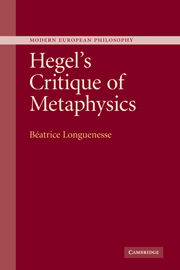Book contents
- Frontmatter
- Contents
- List of Abbreviations
- Note on Citations
- Preface
- PART I HEGEL'S CRITIQUE OF METAPHYSICS: A STUDY OF THE DOCTRINE OF ESSENCE
- Introduction
- 1 Transcendental logic and dialectical logic: from Kant to Hegel, a critique of all dogmatic metaphysics
- 2 Twists and turns of Hegel's contradiction
- 3 Ground against concept?
- 4 What is rational is actual, what is actual is rational
- Conclusion
- PART II POINT OF VIEW OF MAN OR KNOWLEDGE OF GOD
- Notes
- Bibliography
- Index
Conclusion
from PART I - HEGEL'S CRITIQUE OF METAPHYSICS: A STUDY OF THE DOCTRINE OF ESSENCE
- Frontmatter
- Contents
- List of Abbreviations
- Note on Citations
- Preface
- PART I HEGEL'S CRITIQUE OF METAPHYSICS: A STUDY OF THE DOCTRINE OF ESSENCE
- Introduction
- 1 Transcendental logic and dialectical logic: from Kant to Hegel, a critique of all dogmatic metaphysics
- 2 Twists and turns of Hegel's contradiction
- 3 Ground against concept?
- 4 What is rational is actual, what is actual is rational
- Conclusion
- PART II POINT OF VIEW OF MAN OR KNOWLEDGE OF GOD
- Notes
- Bibliography
- Index
Summary
At the outcome of Hegel's chapter on Actuality, we found in the foreground the notion of activity, Tätigkeit.
This notion alone would merit a study taking into account all the aspects and moments of Hegel's system. Within the limits of the present study, I compared it to the activity of synthesis of the “I think” as it finds a place in Kant's critical philosophy. I showed that the activity that, in the last chapter of the Doctrine of Essence, reveals itself in absolute necessity, is the very activity of the concept, that is to say that of the “I think” as it is redefined by Hegel. Hegel's exposition of modal categories thus opens the way to the Doctrine of the Concept.
“The Concept” is certainly not the end point of the Logic. On the contrary it is only the starting point of the “positively dialectical” part of the Logic, the Subjective Logic. My study stops therefore at the point where, for Hegel, the Logic will finally find its true content, speculative rather than merely critical. In the Subjective Logic, the task will be to show how the world in all its guises bears the mark of the unity of the I think. The transition from Subjectivity (Section 1 of the Subjective Logic) to Objectivity (Section 2) will show how the concept confers its unity on the world.
- Type
- Chapter
- Information
- Hegel's Critique of Metaphysics , pp. 160 - 162Publisher: Cambridge University PressPrint publication year: 2007



